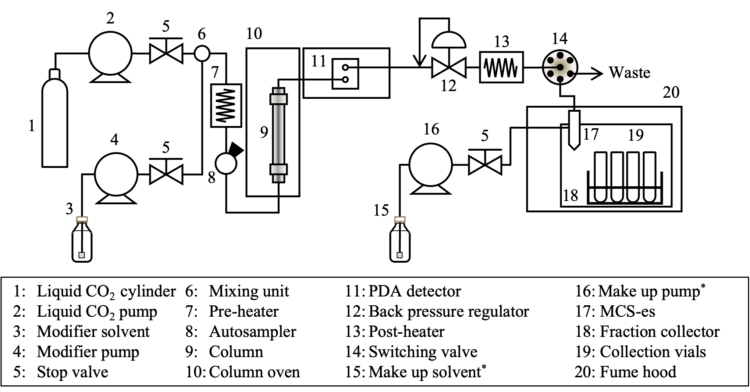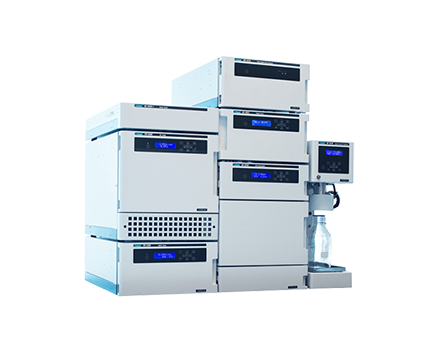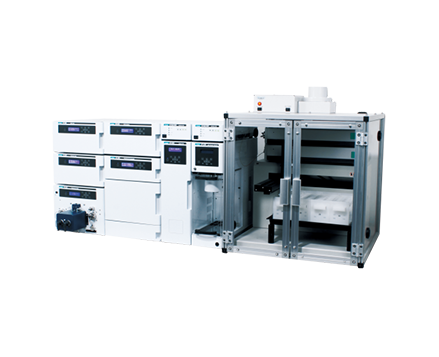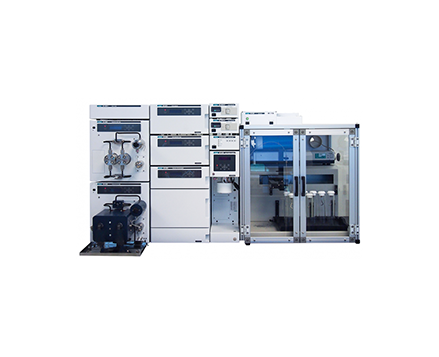Chiral Preparative Fractionation of Warfarin Using a Semi-Preparative Supercritical Fluid Chromatography (SFC) System with a Gas-Liquid Separation Nozzle (MCS-es)
October 21, 2024
Introduction
Preparative separation utilizing Supercritical Fluid Chromatography (SFC) offers several distinctive advantages over traditional chromatography methods. SFC enables higher throughput compared to High-Performance Liquid Chromatography (HPLC). The primary solvent of the mobile phase, supercritical carbon dioxide (CO2), transitions to a gas upon recovery, simplifying post-processing steps, such as evaporation and drying procedures. Furthermore, CO2 is more cost-effective compared to organic solvents and can be sourced in high purity (>99.99%). On the other hand, CO2 experiences the Joule-Thomson cooling effect and undergoes an adiabatic expansion approximately 500 times to 1 when it is exposed to the lower atmospheric pressure at the outlet of the back pressure regulator. Consequently, during preparative separation, it is necessary to take measures to prevent contamination, such as condensed water from sample scattering and sudden temperature drops.
In this application note, it is demonstrated how the installation of the MCS-es, a gas-liquid separation nozzle, on the Z-axis arm of the Gilson 223 Sample Changer fraction collector facilitates the gradual collection of only the liquid phase. This innovative setup effectively minimizes scattering and condensation due to CO2 expansion, enabling efficient preparative separation with high recovery rates across a wide range of flow rates. In addition, it allows for the direct incorporation of make-up solvent into the MCS-es (patent pending). The chiral separation of a warfarin standard solution (5,000 µg/mL warfarin in methanol) was performed using the LC-4000 Series Preparative SFC system in conjunction with the Gilson 223 Sample Changer fraction collector equipped with the MCS–es.
Experimental
SFC System Configuration
| Liquid CO2 Pump | PU-4387 | Back Pressure Regulator (BPR) | BP-4340 |
| Modifier Pump | PU-4087* | Post-heater | HE-02 |
| Pre-heater | HE-02 | Heater Controller | HC-4068-01 |
| Heater Controller | HC-4068-01 | Make Up Pump | PU-4086* |
| Autosampler | AS-4358 | Fraction Valve | FV-4000-06 |
| Column Oven | CO-4060* | Fraction Collector | Gilson 223 |
| Photo Diode Array (PDA) Detector | MD-4010* | Fume Hood | FH-4388 |
| *equipped with optional units | |||
SFC Conditions
| Column | CHIRAKPAK IA (20 mm I.D. x 250 mm L, 5 µm) |
| Mobile Phase (%) | Supercritical carbon dioxide (CO2)/Methanol (MeOH) (60/40) |
| Flow Rate | 50 mL/minute |
| Column Temperature | 35 ºC |
| Wavelength | 200 – 400 nm; 230 nm (CH1) |
| Back Pressure | 10 MPa |
| Post-Heat Temperature | 60 ºC |
| Injection Volume | 1,000 µL |
| Standard Solution | 5,000 µg/mL warfarin in methanol |
SFC System Schematic Diagram
*While not used in this application note, depending on the SFC conditions, the make-up pump is required for making up solvent.
Keywords
Supercritical Fluid Chromatography, SFC, Semi-prep Supercritical Fluid Chromatography, Semi-prep SFC, Semi-preparative Supercritical Fluid Chromatography, Semi-preparative SFC, Supercritical carbon dioxide, supercritical CO2, gas-liquid separator, MCS-es, fraction collector, Gilson 223 Sample Changer, CHIRALPAK IA, chiral preparation, chiral separation
Results

1: Warfarin tR-1, 2: Warfarin tR-2
Figure 1 shows the chromatogram of the warfarin standard solution (5,000 µg/mL warfarin in methanol). Based on this chromatogram, a fraction collection method was created and used for chiral preparative separation of the warfarin standard solution.

1: Warfarin tR-1, 2: Warfarin tR-2
Figure 2 shows the fraction collection results from the chiral preparative separation of a warfarin standard solution containing two enantiomers based on time fractionation; the green section represents the collection phase, and the purple section indicates the drop waiting time*1.
*1 The time taken to collect the modifier and make-up solvent remaining in the MCS-es after valve switching.
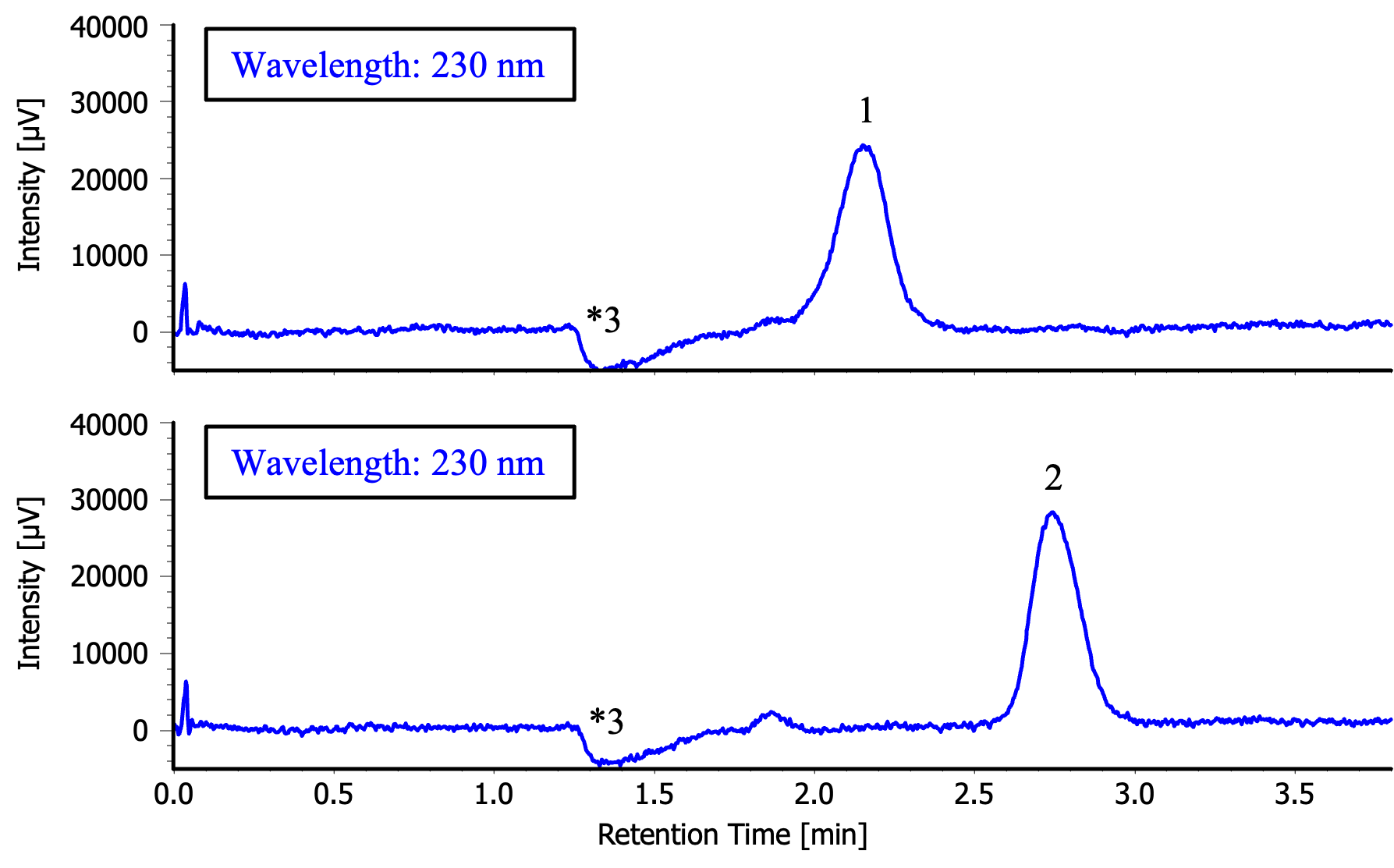
1: Warfarin tR-1 (equivalent to 100 µg/mL),
2: Warfarin tR-2 (equivalent to 100 µg/mL),
*3: Solvent peak
Figure 3 shows the chromatograms obtained by re-measuring each fraction that was collected in Figure 2. Each fraction was diluted to 25 mL by co-washing with methanol so that the concentration of warfarin tR-1 and warfarin tR-2 was 100 µg/mL each (equivalent). These solutions were used for recovery rate measurements.
Table 1 shows the recovery rates for each component, calculated assuming the area values at the time of measurement of the warfarin standard solution as 100% (total 200 µg/mL, 100 µg/mL for both tR-1 and tR-2). Excellent recovery rates were obtained for both enantiomers of the warfarin standard solution.
Table 1. Recovery Rates of the Two Enantiomers in the Warfarin Standard Solution
| tR-1 | tR-2 | |
| Recovery Rate (%) | 93.04 | 97.58 |
Conclusion
The use of the Preparative SFC-M system in conjunction with the Gilson 223 Sample Changer fraction collector equipped with the MCS-es gas-liquid separation nozzles successfully achieved chiral separation and preparation of a warfarin standard solution with excellent recovery rates.
The MCS-es can be used with a maximum total flow rate of up to 200 mL/min (under specified conditions). It also supports preparation at relatively low flow rates on an analytical scale, so it can be applied to preparation over a wide range of flow rates.
Related Products

Chiral Preparative Fractionation of Warfarin Using a Semi-Preparative Supercritical Fluid Chromatography (SFC) System with a Gas-Liquid Separation Nozzle (MCS-es)
Introduction
Preparative separation utilizing Supercritical Fluid Chromatography (SFC) offers several distinctive advantages over traditional chromatography methods. SFC enables higher throughput compared to High-Performance Liquid Chromatography (HPLC). The primary solvent of the mobile phase, supercritical carbon dioxide (CO2), transitions to a gas upon recovery, simplifying post-processing steps, such as evaporation and drying procedures. Furthermore, CO2 is more cost-effective compared to organic solvents and can be sourced in high purity (>99.99%). On the other hand, CO2 experiences the Joule-Thomson cooling effect and undergoes an adiabatic expansion approximately 500 times to 1 when it is exposed to the lower atmospheric pressure at the outlet of the back pressure regulator. Consequently, during preparative separation, it is necessary to take measures to prevent contamination, such as condensed water from sample scattering and sudden temperature drops.
In this application note, it is demonstrated how the installation of the MCS-es, a gas-liquid separation nozzle, on the Z-axis arm of the Gilson 223 Sample Changer fraction collector facilitates the gradual collection of only the liquid phase. This innovative setup effectively minimizes scattering and condensation due to CO2 expansion, enabling efficient preparative separation with high recovery rates across a wide range of flow rates. In addition, it allows for the direct incorporation of make-up solvent into the MCS-es (patent pending). The chiral separation of a warfarin standard solution (5,000 µg/mL warfarin in methanol) was performed using the LC-4000 Series Preparative SFC system in conjunction with the Gilson 223 Sample Changer fraction collector equipped with the MCS–es.
Experimental
SFC System Configuration
| Liquid CO2 Pump | PU-4387 | Back Pressure Regulator (BPR) | BP-4340 |
| Modifier Pump | PU-4087* | Post-heater | HE-02 |
| Pre-heater | HE-02 | Heater Controller | HC-4068-01 |
| Heater Controller | HC-4068-01 | Make Up Pump | PU-4086* |
| Autosampler | AS-4358 | Fraction Valve | FV-4000-06 |
| Column Oven | CO-4060* | Fraction Collector | Gilson 223 |
| Photo Diode Array (PDA) Detector | MD-4010* | Fume Hood | FH-4388 |
| *equipped with optional units | |||
SFC Conditions
| Column | CHIRAKPAK IA (20 mm I.D. x 250 mm L, 5 µm) |
| Mobile Phase (%) | Supercritical carbon dioxide (CO2)/Methanol (MeOH) (60/40) |
| Flow Rate | 50 mL/minute |
| Column Temperature | 35 ºC |
| Wavelength | 200 – 400 nm; 230 nm (CH1) |
| Back Pressure | 10 MPa |
| Post-Heat Temperature | 60 ºC |
| Injection Volume | 1,000 µL |
| Standard Solution | 5,000 µg/mL warfarin in methanol |
SFC System Schematic Diagram
*While not used in this application note, depending on the SFC conditions, the make-up pump is required for making up solvent.
Results

1: Warfarin tR-1, 2: Warfarin tR-2
Figure 1 shows the chromatogram of the warfarin standard solution (5,000 µg/mL warfarin in methanol). Based on this chromatogram, a fraction collection method was created and used for chiral preparative separation of the warfarin standard solution.

1: Warfarin tR-1, 2: Warfarin tR-2
Figure 2 shows the fraction collection results from the chiral preparative separation of a warfarin standard solution containing two enantiomers based on time fractionation; the green section represents the collection phase, and the purple section indicates the drop waiting time*1.
*1 The time taken to collect the modifier and make-up solvent remaining in the MCS-es after valve switching.

1: Warfarin tR-1 (equivalent to 100 µg/mL),
2: Warfarin tR-2 (equivalent to 100 µg/mL),
*3: Solvent peak
Figure 3 shows the chromatograms obtained by re-measuring each fraction that was collected in Figure 2. Each fraction was diluted to 25 mL by co-washing with methanol so that the concentration of warfarin tR-1 and warfarin tR-2 was 100 µg/mL each (equivalent). These solutions were used for recovery rate measurements.
Table 1 shows the recovery rates for each component, calculated assuming the area values at the time of measurement of the warfarin standard solution as 100% (total 200 µg/mL, 100 µg/mL for both tR-1 and tR-2). Excellent recovery rates were obtained for both enantiomers of the warfarin standard solution.
Table 1. Recovery Rates of the Two Enantiomers in the Warfarin Standard Solution
| tR-1 | tR-2 | |
| Recovery Rate (%) | 93.04 | 97.58 |
Conclusion
The use of the Preparative SFC-M system in conjunction with the Gilson 223 Sample Changer fraction collector equipped with the MCS-es gas-liquid separation nozzles successfully achieved chiral separation and preparation of a warfarin standard solution with excellent recovery rates.
The MCS-es can be used with a maximum total flow rate of up to 200 mL/min (under specified conditions). It also supports preparation at relatively low flow rates on an analytical scale, so it can be applied to preparation over a wide range of flow rates.
Keywords
Supercritical Fluid Chromatography, SFC, Semi-prep Supercritical Fluid Chromatography, Semi-prep SFC, Semi-preparative Supercritical Fluid Chromatography, Semi-preparative SFC, Supercritical carbon dioxide, supercritical CO2, gas-liquid separator, MCS-es, fraction collector, Gilson 223 Sample Changer, CHIRALPAK IA, chiral preparation, chiral separation

 Download This Application
Download This Application
